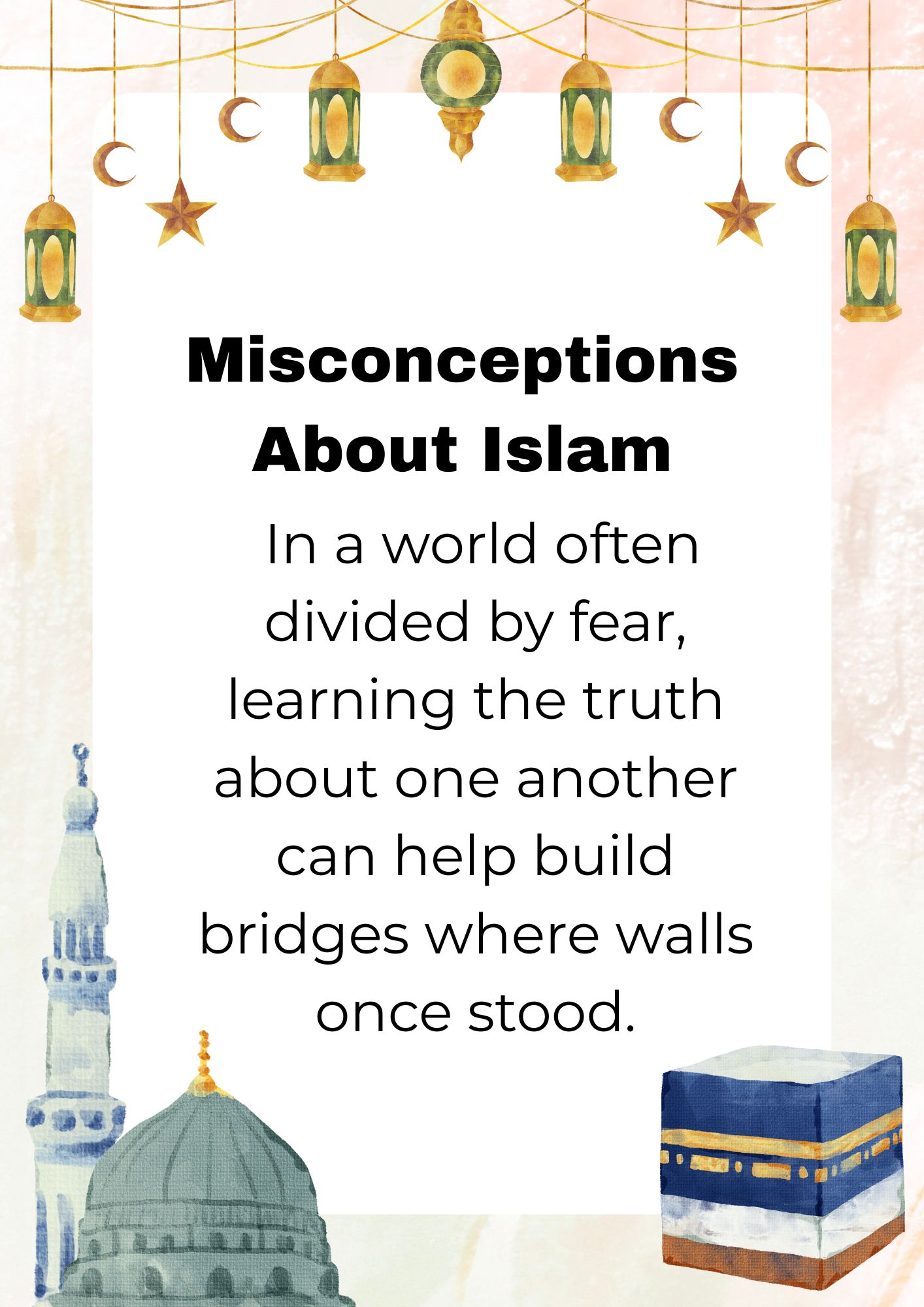Misconceptions About Islam: A Guide for Non-Muslims
Islam is one of the world’s major religions, with nearly two billion followers across the globe. Despite its widespread presence and profound influence on history, art, and philosophy, Islam is often misunderstood—particularly in the West. These misconceptions can lead to fear, prejudice, and even discrimination. This guide aims to clarify some of the most common misunderstandings and provide a more accurate picture of what Islam truly teaches.
1. Islam Promotes Violence
One of the most damaging myths about Islam is that it encourages violence or terrorism. This belief is often fueled by news coverage of extremist groups who claim to act in the name of Islam. However, these actions represent political agendas—not religious teachings.
Islam, at its core, promotes peace. The word “Islam” itself is derived from the Arabic root “s-l-m,” which means peace and submission to God. Muslims are taught to treat others with kindness, respect, and compassion. Like in all major religions, there are concepts of justice and self-defense, but Islam does not condone the killing of innocent people under any circumstance.
2. All Muslims Are Arabs
Another common assumption is that all Muslims are from the Middle East or are Arabs. In reality, only a small percentage of the world’s Muslim population is Arab. The largest populations of Muslims live in countries like Indonesia, Pakistan, India, and Bangladesh. Islam is a global religion that crosses racial, ethnic, and national boundaries.
Muslims come from every background, culture, and language. While Arabic is the language of the Qur’an, Muslims around the world come from diverse linguistic and ethnic communities. This diversity is one of the strengths of the Muslim world.
3. Muslim Women Are Oppressed
The image of the “oppressed Muslim woman” has been widely circulated, often without understanding the cultural or religious context. In Islam, women are granted many rights, including the right to education, to own property, to work, and to participate in political and social life. The idea that Muslim women are universally oppressed is a generalization that ignores the varied realities of Muslim women’s lives.
In many cases, cultural traditions—not Islamic teachings—are responsible for gender inequality. It’s important to separate cultural practices from religious principles. Many Muslim women proudly practice their faith and wear religious attire, such as the hijab, out of personal choice and religious devotion, not because they are forced to.
4. The Hijab Is a Symbol of Oppression
The hijab, or headscarf worn by many Muslim women, is often misunderstood. To many, it is seen as a symbol of restriction, but to those who wear it, it is a symbol of modesty, faith, and identity. Just as people of other religions choose modest dress as a sign of devotion, Muslim women often wear the hijab as an act of personal and spiritual expression.
The decision to wear a hijab can be deeply empowering. It allows many women to be recognized for their intellect and character rather than their appearance. Assuming that all hijab-wearing women are oppressed denies them the agency and voice they deserve.
5. Jihad Means “Holy War”
The term “jihad” is often mistranslated and misunderstood. While it has been sensationalized as a term for religious war, its actual meaning in Arabic is “struggle” or “striving.” The most important form of jihad in Islam is the personal, internal struggle to live a righteous life and resist temptation.
There is a lesser form of jihad that refers to physical struggle, which includes defending one’s land or family, but even then, it is strictly governed by rules about justice, ethics, and the protection of civilians. Jihad is not a blanket call for violence but a complex concept rooted in spiritual and moral effort.
6. Sharia Law Is Harsh and Unfair
Sharia, or Islamic law, is often portrayed as a rigid and oppressive system. However, in its truest form, Sharia is a broad framework for ethical and spiritual living. It includes guidance on everything from family matters to finance, from charity to worship.
Much of what is feared about Sharia comes from extreme or distorted versions used in some countries. In practice, the majority of Muslims view Sharia as a personal code that helps them live morally and spiritually, not as a political or judicial system to impose on others.
7. Islam Is Intolerant of Other Religions
Islam has a long history of coexistence with other faiths. The Qur’an acknowledges the existence of Jews and Christians as “People of the Book” and recognizes the truth found in earlier scriptures. Historically, Islamic civilizations have included religious minorities who lived and practiced their beliefs freely.
Respect for others, regardless of religion, is a core Islamic value. Muslims are encouraged to engage in peaceful dialogue, mutual understanding, and cooperation with people of all backgrounds. The idea that Islam teaches hatred for non-Muslims is a harmful distortion of its teachings.
Conclusion
Understanding Islam requires more than headlines and stereotypes. It demands a willingness to learn, to ask questions, and to see Muslims as individuals with diverse experiences and beliefs. While no religion is free from misuse or misunderstanding, Islam—like Christianity, Judaism, and other faiths—encourages values of compassion, justice, and peace.
By addressing these misconceptions, we take a step toward greater mutual understanding and respect. In a world often divided by fear, learning the truth about one another can help build bridges where walls once stood.
- Info@salihaonlineacademy.com
- Chaman Zar Colony, Rawalpindi
- Sunrise At: 5:15 AM
- Sunset At: 4:50 PM
- Let’s Talk +923301790195


Leave A Comment